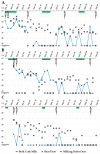Surveillance of Coxiella burnetii Shedding in Three Naturally Infected Dairy Goat Herds after Vaccination, Focusing on Bulk Tank Milk and Dust Swabs
- PMID: 35324830
- PMCID: PMC8950187
- DOI: 10.3390/vetsci9030102
Surveillance of Coxiella burnetii Shedding in Three Naturally Infected Dairy Goat Herds after Vaccination, Focusing on Bulk Tank Milk and Dust Swabs
Abstract
Q fever outbreaks on three dairy goat farms (A-C) were monitored after the animals had been vaccinated with an inactivated Coxiella burnetii phase I vaccine. The antibody response was measured before vaccination by serum samples with two C. burnetii phase-specific ELISAs to characterize the disease status. Shedding was determined by vaginal swabs during three kidding seasons and monthly bulk tank milk (BTM) samples. Dust swabs from one windowsill of each barn and from the milking parlors were collected monthly to evaluate the indoor exposure. These samples were analyzed by qPCR. The phase-specific serology revealed an acute Q fever infection in herd A, whereas herds B and C had an ongoing and past infection, respectively. In all three herds, vaginal shedders were present during three kidding seasons. In total, 50%, 69%, and 15% of all collected BTM samples were C. burnetii positive in herds A, B, and C, respectively. Barn dust contained C. burnetii DNA in 71%, 45%, and 50% of examined swabs collected from farms A, B, and C, respectively. The largest number of C. burnetii positive samples was obtained from the milking parlor (A: 91%, B: 72%, C: 73%), indicating a high risk for humans to acquire Q fever during milking activity.
Keywords: One Health; Q fever; bulk tank milk; dust swab; goat; longitudinal study; milking parlor; phase-specific serology; vaccination; zoonosis.
Conflict of interest statement
The authors declare no conflict of interest.
Figures



Similar articles
-
Two Years after Coxiella burnetii Detection: Pathogen Shedding and Phase-Specific Antibody Response in Three Dairy Goat Herds.Animals (Basel). 2023 Sep 28;13(19):3048. doi: 10.3390/ani13193048. Animals (Basel). 2023. PMID: 37835654 Free PMC article.
-
Coxiella burnetii infection persistence in a goat herd during seven kidding seasons after an outbreak of abortions: the effect of vaccination.Appl Environ Microbiol. 2024 Mar 20;90(3):e0220123. doi: 10.1128/aem.02201-23. Epub 2024 Feb 27. Appl Environ Microbiol. 2024. PMID: 38412030 Free PMC article.
-
Bulk tank milk surveillance as a measure to detect Coxiella burnetii shedding dairy goat herds in the Netherlands between 2009 and 2014.J Dairy Sci. 2015 Jun;98(6):3814-25. doi: 10.3168/jds.2014-9029. Epub 2015 Mar 18. J Dairy Sci. 2015. PMID: 25795490
-
Analysis of Q fever in Dutch dairy goat herds and assessment of control measures by means of a transmission model.Prev Vet Med. 2016 Jan 1;123:71-89. doi: 10.1016/j.prevetmed.2015.11.004. Epub 2015 Nov 18. Prev Vet Med. 2016. PMID: 26708798
-
Molecular prevalence of Coxiella burnetii in bulk-tank milk from bovine dairy herds: Systematic review and meta-analysis.One Health. 2020 Dec 24;12:100208. doi: 10.1016/j.onehlt.2020.100208. eCollection 2021 Jun. One Health. 2020. PMID: 33553561 Free PMC article. Review.
Cited by
-
Longitudinal surveillance of Coxiella burnetii following an abortion storm in domestic goats.Front Vet Sci. 2024 Sep 13;11:1426573. doi: 10.3389/fvets.2024.1426573. eCollection 2024. Front Vet Sci. 2024. PMID: 39346957 Free PMC article.
-
Efficacy and Safety of an Inactivated Phase I Coxiella burnetii Vaccine to Control Q Fever in Ruminants: A Systematic Review.Animals (Basel). 2024 May 16;14(10):1484. doi: 10.3390/ani14101484. Animals (Basel). 2024. PMID: 38791700 Free PMC article. Review.
-
Tracking the Source of Human Q Fever from a Southern French Village: Sentinel Animals and Environmental Reservoir.Microorganisms. 2023 Apr 13;11(4):1016. doi: 10.3390/microorganisms11041016. Microorganisms. 2023. PMID: 37110439 Free PMC article.
-
Impact of Coxiella burnetii vaccination on humoral immune response, vaginal shedding, and lamb mortality in naturally pre-infected sheep.Front Vet Sci. 2022 Dec 19;9:1064763. doi: 10.3389/fvets.2022.1064763. eCollection 2022. Front Vet Sci. 2022. PMID: 36601330 Free PMC article.
-
Two Years after Coxiella burnetii Detection: Pathogen Shedding and Phase-Specific Antibody Response in Three Dairy Goat Herds.Animals (Basel). 2023 Sep 28;13(19):3048. doi: 10.3390/ani13193048. Animals (Basel). 2023. PMID: 37835654 Free PMC article.
References
-
- Mertens K., Gerlach C., Neubauer H., Henning K. Q fever—An Update. Curr. Clin. Microbiol. Rep. 2017;4:61–70. doi: 10.1007/s40588-017-0059-5. - DOI
-
- Bauer B.U., Runge M., Campe A., Henning K., Mertens-Scholz K., Boden K., Sobotta K., Frangoulidis D., Knittler M.R., Matthiesen S., et al. Coxiella burnetii: A review focusing on infections in German sheep and goat flocks. Berl. Munch. Tierarztl. Wochenschr. 2020;133:184–200. doi: 10.2376/0005-9366-19030. - DOI
Grants and funding
LinkOut - more resources
Full Text Sources
Miscellaneous

